Here at Wine Lister we’re continually importing and crunching new data to ensure our scores reflect the most up to date picture of each wine’s quality, brand strength, and economic performance.
Economics scores, which comprise five criteria, including six-month price performance and price stability, are updated each week to capture the latest wine price data from our price data partner Wine Owners. Meanwhile Brand scores are updated every month to reflect changes in online search data – how often a wine is searched for on partner site Wine-Searcher.
Now we’ve added a new tool to the site allowing users to track the evolution of every wine’s score over time, identifying how and why the score has changed following each data update.
The interactive chart shows how a wine’s overall Wine Lister score, as well as its category scores, have changed over time, and includes flags to show users what data was updated and when.
For example, using the tool for Giuseppe Quintarelli Alzero, you can see its brand score shoot up in July 2017. The flag tells us this was due to a search statistics update (it turns out LeBron James posted a photo on Instagram of a bottle of the 2007 that he was enjoying):
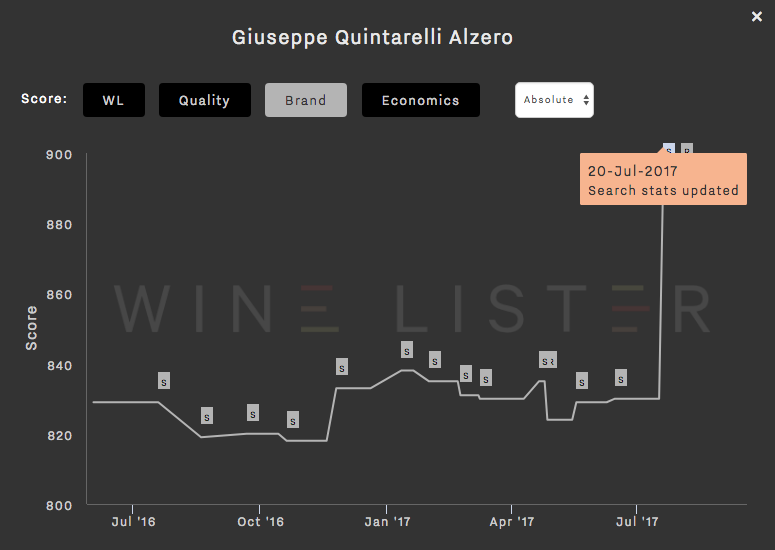
The tool also allows the different category scores to be rebased enabling easy comparison of their relative performance over time. Try it out for yourself by searching any wine and clicking “View score history”, on the wine page, underneath the category score bars:

Vérité Le Désir 2014 has been released this morning with a UK RRP of £300 per bottle. We summarise all the key points below:
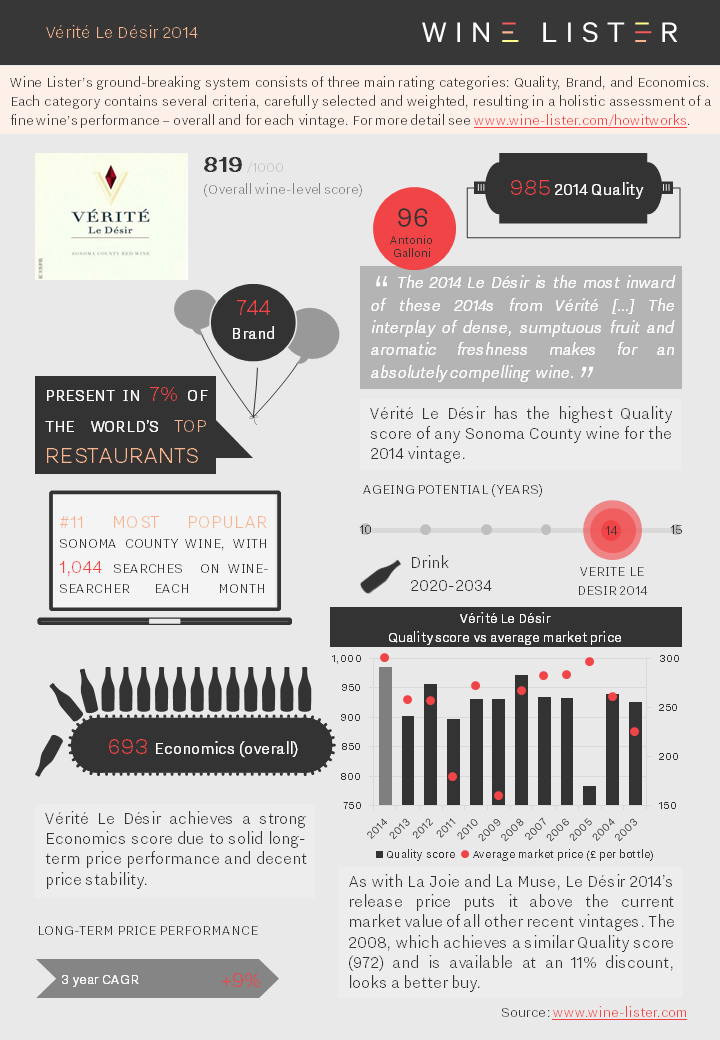
You can download the slide here: Wine Lister Factsheet Vérité Le Désir 2014
Vérité La Muse 2014 has been released this morning with a UK RRP of £300 per bottle. Our factsheet summarises all the key points:
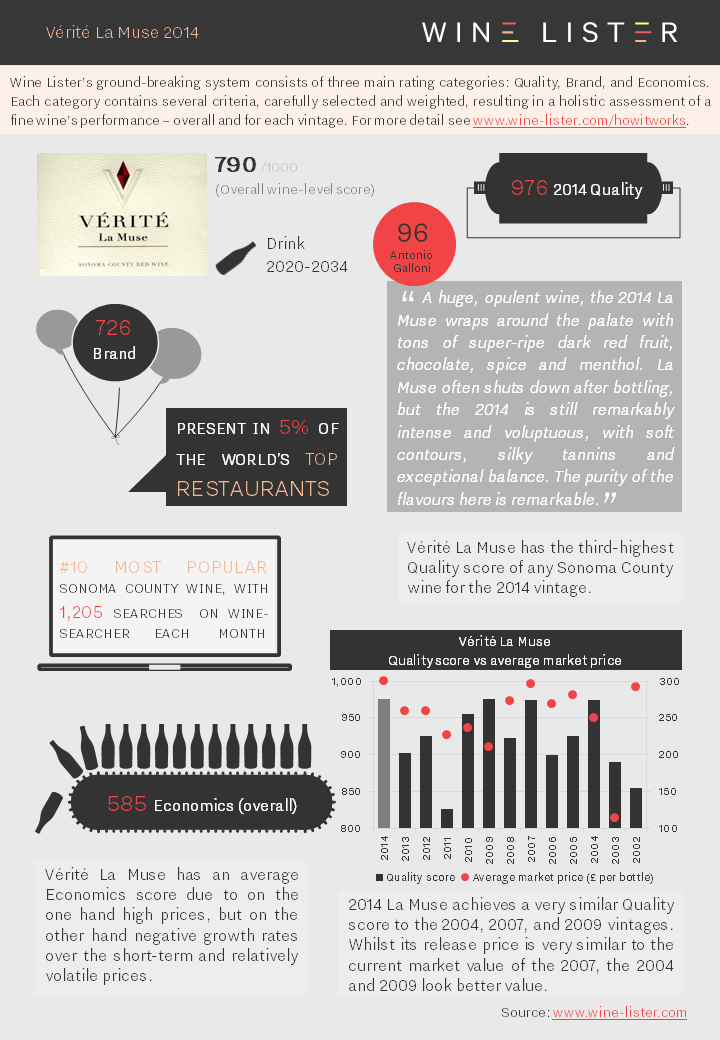
You can download the slide here: Wine Lister Factsheet Vérité La Muse 2014
Vérité La Joie 2014 has been released today with a UK RRP of £300. We summarise all the key facts below:
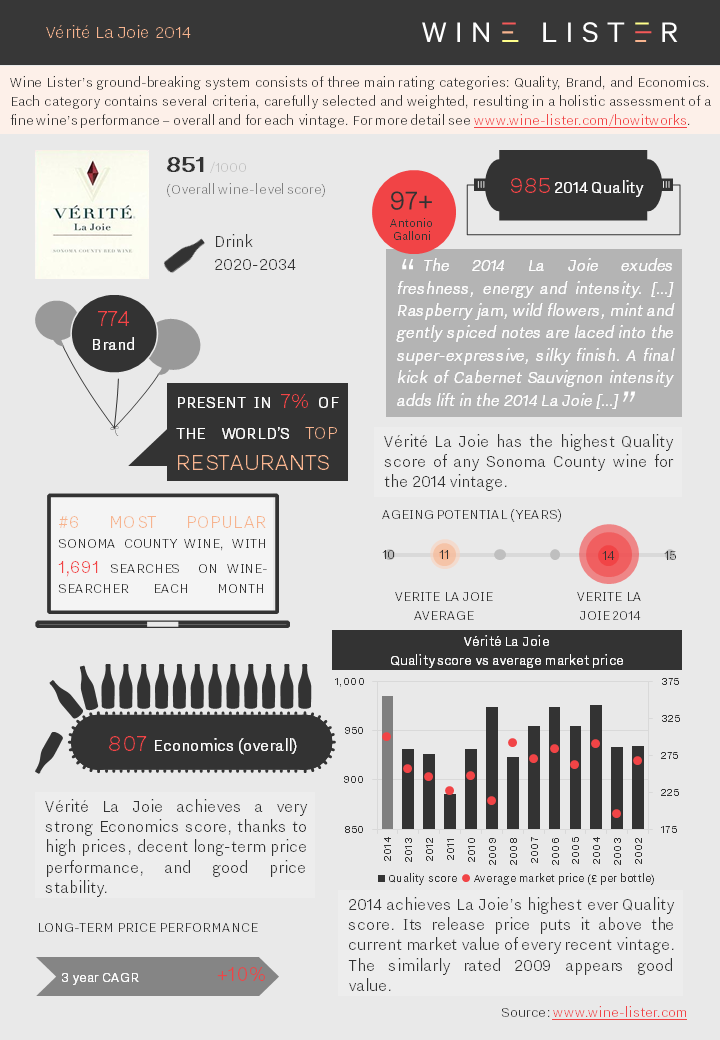
You can download the slide here: Wine Lister Factsheet Vérité La Joie 2014
Hommage à Jacques Perrin 2015 has been released today at £247 per bottle. We summarise all the key facts below:
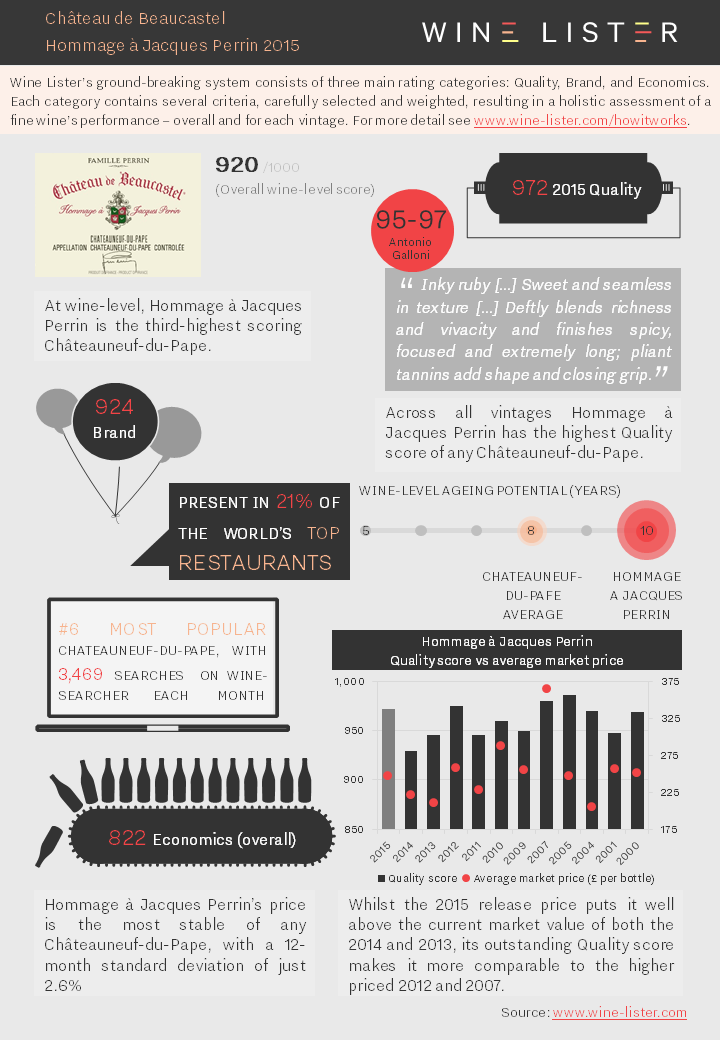
You can download the slide here: Wine Lister Factsheet Hommage à Jacques Perrin 2015
Stretching from the Atlantic coast in the West to Pouilly-sur-Loire in the East, the Loire Valley extends half way across France, and is home to some of the country’s great white wines. Reflecting the diversity of the region, the Loire’s top five whites comprise two dry Sauvignon Blancs, two sweet Chenin Blancs, and a dry Chenin Blanc. However, whilst these wines are diverse in style, they share several key characteristics – they are all produced biodynamically, in small quantities, and by cult winemakers.
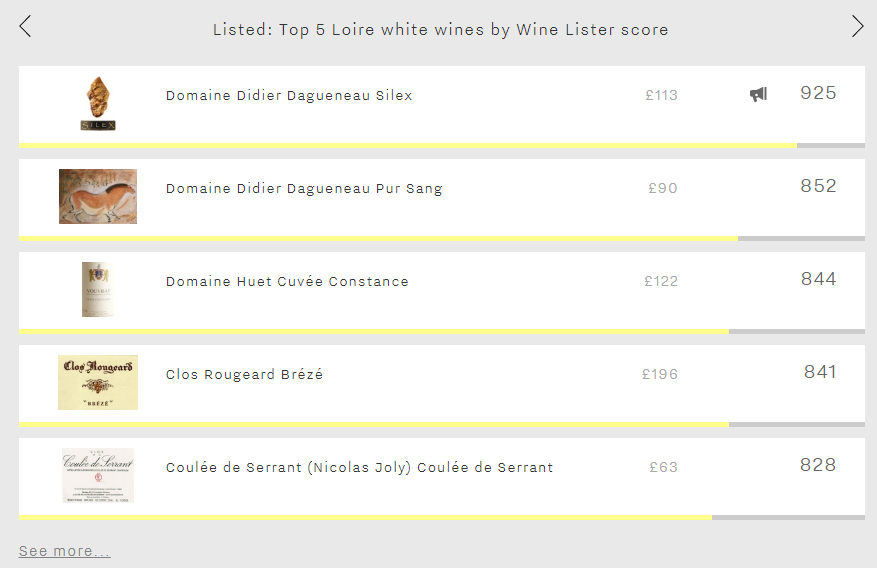
Leading the way are two Pouilly-Fumés from Domaine Didier Dagueneau – Silex and Pur Sang. One of Wine Lister’s Buzz Brands, Silex achieves excellent scores in each of Wine Lister’s three categories. However, it enjoys particularly strong brand recognition, present in 39% of the world’s best restaurants and receiving on average over 4,000 searches each month on Wine-Searcher. Pur Sang achieves its best score in the Economics category, thanks to strong price performance – with a three year CAGR of 14% and a six month growth rate of 13%.
Moving West to Vouvray, Domaine Huet Cuvée Constance comes next. Produced only in great vintages, this botrytised Chenin Blanc has the best Quality score of the group (981), and the 14th highest of all white wines on Wine Lister.
Continuing further down the valley, Clos Rougeard Brézé is in fourth place. The most expensive wine of the group, it has a remarkable three year CAGR of 33%, confirming that it is a wine on a strong upward trajectory. The fifth wine is Nicolas Joly’s Coulée de Serrant. Produced in the most westerly appellation of the group – Savennières Coulée de Serrant – Brand is its strongest category, present in 31% of top establishments.
Don’t forget – if you’re not yet a subscriber to Wine Lister, you can still fully explore this week’s five Listed wines, and those for the previous four weeks, via the homepage.
The 1855 Bordeaux classification might well be considered one of the earliest examples of a wine rating system. Classifying wines by six categories – including “unclassified” – might seem restrictive now (compared to Wine Lister’s 1,000 point scale), but the classification has proven to be highly influential and durable. This week’s Listed section focuses on the five Bordeaux fifth growths with the highest overall Wine Lister score, giving us an opportunity to see how the 160-year-old classification stacks up today.
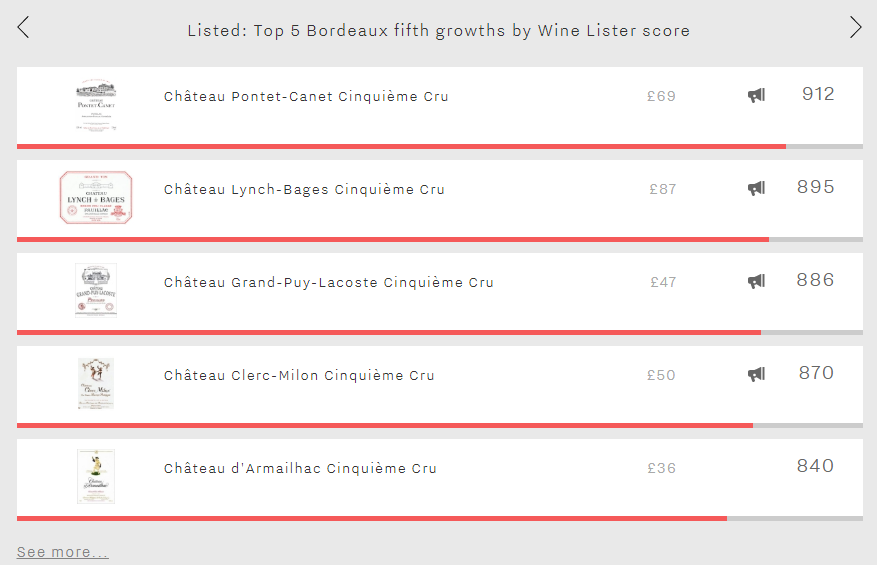
Whilst the 1855 classification used price as the yardstick by which a wine should be rated, Wine Lister’s holistic approach also takes into account quality, brand strength, and other economic metrics. The outcome is that with an average Wine Lister score of 881, these flying fifths outperform both the top five performing third growths and fourth growths (average of 863 and 834 respectively), beating the two classes across every category. Nonetheless, the top fifth growths trail the most highly-rated second growths and the five first growths by 48 and 86 points respectively overall.
Pontet-Canet is the leading fifth growth, with a score of 912. While all five wines perform well in terms of Brand score, Pontet-Canet’s first place position is supported by an excellent Quality score of 905, nearly 60 points above Grand-Puy-Lacoste, the second highest rated of the five in terms of quality.
Lynch-Bages comes next. Whilst it performs well in the Quality and Economics categories, it is in the Brand category that it comes into its own, with a near-perfect score of 998 putting it alongside first growths Haut-Brion and Margaux.
Grand-Puy-Lacoste takes third place with 886, scoring well across the board. It is one of the four Buzz Brands of the group, a fact which confirms that these top fifth growths currently confer more prestige than their third and fourth growth counterparts, which see fewer Buzz Brands within their respective top fives.
The last two spots are filled by wines from the Baron Philippe de Rothschild stable – Clerc-Milon and d’Armailhac. The former achieves the highest Economics score of the group – 908 – thanks to excellent price performance over both the long and short-term. Meanwhile, d’Armailhac’s score of 840, whilst 30 points below Clerc-Milon, puts it above all but four third and fourth growths.
These results blur the lines between the traditional classifications, demonstrating that price can no longer be looked at in isolation, and suggesting that a more nuanced and flexible approach needs to be taken in rating wines.
Remember that there are many ways to search Wine Lister, including by score, geography, and classification – which is how we calculated the findings above.
Opus One 2014 was released today at £210 per bottle. Described as a “gorgeous wine” by Wine Lister partner critic Antonio Galloni, we summarise all the key information below:
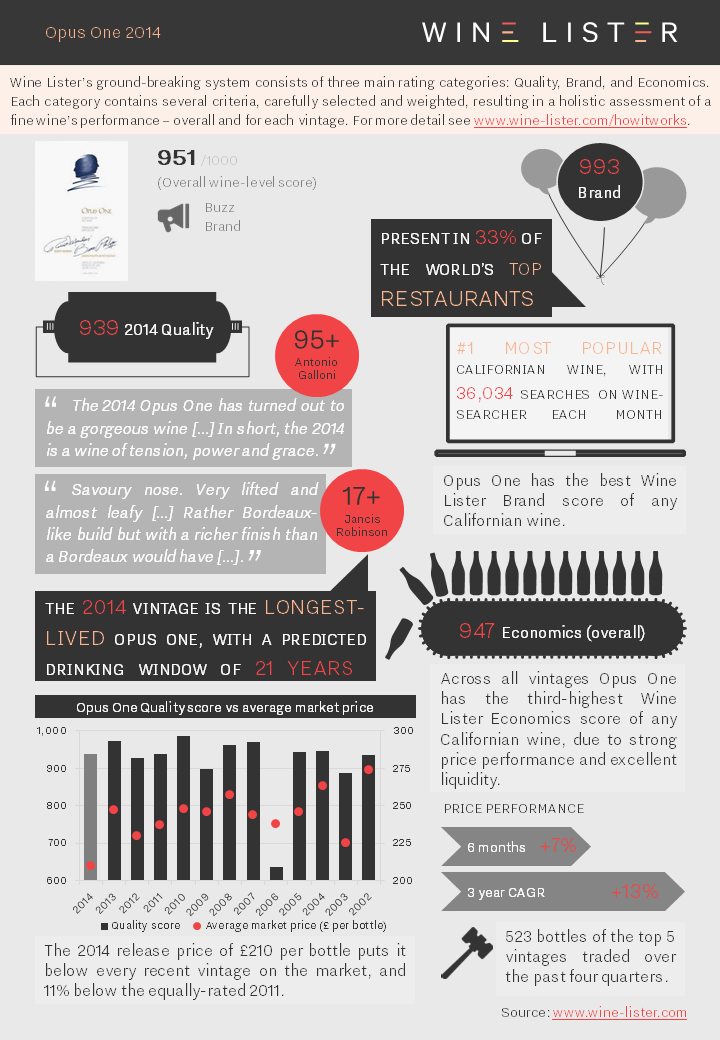
You can download the slide here: Wine Lister Factsheet Opus One 2014
One of Wine Lister’s four Indicators, Value Picks identify the wines and vintages which have the best quality to price ratio, with a proprietary weighting giving more importance to quality, thus giving the finest wines a look-in.
With the latest price data in, 28 new wines have recently qualified as Value Picks. While Value Picks are calculated using a three-month average bottle score for accuracy (in order to take into account any price fluctuations), we have shown the current price per bottle below for ease of comparison. Please note that the price shown is excluding duty and VAT, and often reflects prices available only when purchasing a full case:
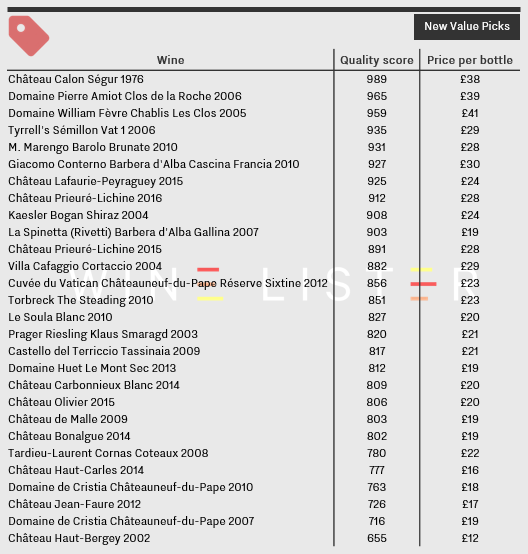
Bordeaux dominates the new Value Picks, filling 11 of the 28 spots. Margaux’s Prieuré-Lichine seems a particularly keenly-priced brand at the moment, with both its 2015 and 2016 vintages now Value Picks. With Wine Lister Quality scores of 891 and 912 respectively – very strong and amongst the strongest on Wine Lister’s 1000 point scale – and both priced under £30, they represent excellent value buys. Within Bordeaux, Pessac-Léognan is home to the highest number of new Value Picks. Of those, two are white, with Château Carbonnieux Blanc 2014 and Château Olivier 2015 achieving very similar Quality scores (809 and 806 respectively), and each priced at just £20.
The other wine to feature twice in the latest update is Domaine de Cristia Châteauneuf-du-Pape, with its 2010 and 2007 vintages. The former, which achieves a Quality score of 763, is available at just £18 per bottle. With plenty of life left in it, it looks like a great buy.
Three Piedmontese wines recently qualified as Value Picks – M. Marengo Barolo Brunate 2010, Giacomo Conterno Barbera d’Alba Cascina Francia 2010, and La Spinetta (Rivetti) Barbera d’Alba Gallina 2007. All three achieve powerful Wine Lister Quality scores of over 900 points. You might buy Giacomo Conterno’s wines to impress – the Barolo Cascina Francia is a Wine Lister Buzz Brand, but also averages £157 per bottle. If you’re looking for something more appropriate for a weeknight, the 2010 vintage of the same producer’s Barbera d’Alba, priced at just £30, would be an excellent Value Pick – a perfect example of how Wine Lister’s indicators can help you find the right wine for any situation.









